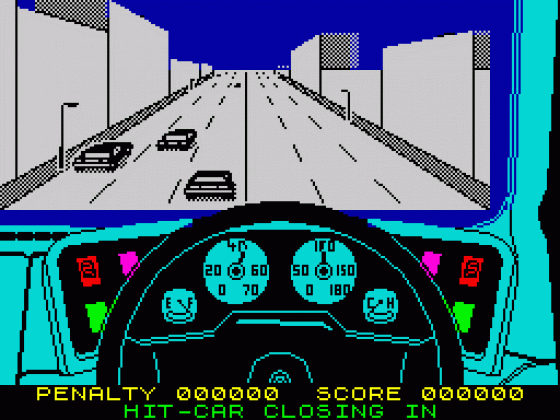
ZX Computing
 1st April 1986
1st April 1986
Categories: Preview: Software
Published in ZX Computing #24
Ray Elder test drives Durells Turbo Esprit
Life In The Fast Lane
The building hasn't changed from the last time I visited them two years ago, but the unassuming cars parked outside were less rusty and had more wheels.
Inside, Mike Richardson, programmer of Durell's Spectrum games and occasionally some on other machines, was about to demonstrate the preliminary version of Turbo Esprit to Richard White, revered head of the company. I had been invited along to witness this event.
The plot of the game had in fact undergone slight modification from the original concept, and Mike was explaining this to a critical Robert when I arrived. The game is not just another driving simulation. Both Mike and Robert share the belief that simulations tend to become boring, but Turbo Esprit shares the game general concept as Combat Lynx, that os an arcade strategy game. The driving is a skill in its own right, but simplified - i.e. this car is fitted with automatic gear change!

The purpose of the game is to foil an international gang of drug dealers who are about to smuggle in a shipment of drugs in an unmarked armoured car. The drugs will be transferred to ordinary dealers' distribution cars where they will be taken to various secret hideouts. Once the drugs have been transferred then it's up to you to stop that supply by either shooting the distributor's car or bumping into it until they surrender. This of course means a high speed chase around the city.
When the armoured car has made four deliveries you can then try to force it to surrender (shooting it has no effect).
The bottom half of the screen is a colourful and well designed area that shows the car's dashboard, revs, speed, fuel and temperature. Messages are also flashed up in this area and you can expect warnings of lack of fuel and engine problems among others.
The top half of the screen can toggle between a 3D solid perspective view of the city and your car - rear or side view - and a map. The 3D view is the main driving screen and shows the direction you are travelling in, with the city street scrolling towards you. Though the buildings are featureless blocks, the rest of the detail is superb. Pedestrians, other motorists, traffic lights and roadworks complete with little flashing warning lights are included. This is mainly in black and white with occasional use of colour for enemy cars.
The map screen is for getting your bearings and tracking the movements of the gang's cars. It shows the city to be essentially a 30 x 30 grid. It also shows a feature which had been at the back of my mind while driving on the 3D screen, the city roads are laid out in straight lines with right angled intersections. Certainly not like any city I've driven in, but perhaps this is the way it will be in the future?
You gain points for completing each section of the task and lose points for injuring or destroying innocent bystanders and their cars. Oh, and the gang has their own squad of hit cars which roam the streets trying to destroy you!
Mike told me that the game, though nearly complete, may be modified before it reaches the shops, but as it stands the graphics are excellent though sound is minimal. I loved simply driving around the streets and got into some glorious jams.
Chasing the gang's cars was much more difficult, Robert and I were hopeless, though Mike did it with ease (but then, he wrote it). As I left, snatches of conversation floating down the stairs.
"Four difficulty levels?"
"OK, could be the speed of the gang's cars, how about a choice of black gang cars or coloured, that'll make it more difficult?"
"Joystick and user-defined keys of course"
"Of course."
"How about having a targetting system when shooting at the enemy cars..."



